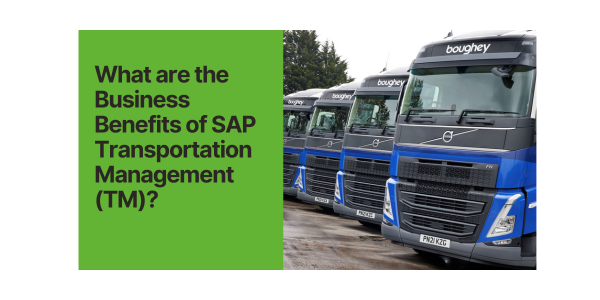What are the Business Benefits of SAP Transportation Management (TM)?
Jim Lodwick
Jun 5, 2018 9:01:00 AM

Whether you're looking to optimise your business processes or streamline your operations, we have the expertise and experience to help you achieve project success.
Contact us today to discuss your needs further.
Learn how our SAP solution extensions can help your workforce reduce reliance on manual paper based activities and ensuring the ever changing needs of your supply chain operational workforce is supported.
Book a demo to learn more.
We work closely with our clients to understand their unique needs and challenges. Explore our SAP expertise services to learn more.

Measuring logistical efficiency when you are already doing the best job possible seems futile, right?
Transport providers of all shapes and sizes are continuously being asked to jump through new hoops and clear more challenging hurdles — so what value could reporting really play?
Data provides a media to analyse previous trends, as well as understand key cost drivers and results of business decisions. It creates the ability to predict and forecast future performance. Not only this, but data can be used to model new scenarios and understand their impact prior to going into a go-live scenario.
Read more: The Real-time Route to 21st Century Logistics
Such techniques are innovative and drive best practice. What would happen, for example, if I changed the mix of own versus third-party fleet? What impact would it have on not only fleet numbers, but the bottom line if I could increase utilisation?
As we analyse data streams looking for trends and innovative approaches, there are often many underlying factors which have an impact. The ability to be able to drill into the detail and view contributory variables is key to ensuring the foundation for improvement is sustainable. Not only is it important to understand the influencing factors, but it is key to understand how change will impact wider approaches. It is imperative that we do not have a siloed view of any savings and that we avoid any potential on costs in wider integrated processes.
A saving to reduce mobile storage media may have an impact on remaining warehouse space and may consequently bring operations to a standstill. Perhaps a consolidation opportunity to reduce the cost of inbound raw materials is not as rosy as it first appears when production and sales processes are negatively impacted — as we recently saw with KFC and DHL.
Often visibility is marred by the systems platforms and architectures we have in place. As more and more systems are integrated together it becomes increasingly difficult to amalgamate and consolidate the data. Have we captured all the salient data or do we have gaps? Indeed, is all the information from supporting systems up to date? Manual processes requiring physical keying of data add to the issues, requiring administration overhead while typically compromising accuracy because of keying errors such as transpositions. As you can see, there is a potential minefield in getting to the correct base data to support the ongoing management decision making. Where the data has inaccuracies the decisions we make are undermined.
Not only is it imperative to make sure that our base data is accurate, but the next step is to ensure we are monitoring the right metrics. Monitoring the weight utilisation of vehicles cubed out with pallets of crisps is a little pointless, however monitoring opportunities to further maximise both cube and weight by combining heavier and lighter goods creates much more value. Equally, measurements need to align closely with and underpin business strategy ensuring continuous buy-in. Using the correct measurements will not only allow you to monitor current performance, but lead you into change management driving greater efficiency.
Rocket Consulting have demonstrable success spanning nearly two decades of SAP Transportation Management implementations and continually draw on our ever-expanding experience tailoring solutions to client’s specific requirements driving best practice methodologies, optimum efficiencies and maximum customer performance.
We have been able to help our customers decrease administration costs, saving up to 50% in charge management administration and reducing invoice errors by an average of 13% with automated freight settlement.
Our experience in implementing automated optimisation can reduce planning overheads by as much as 60%.